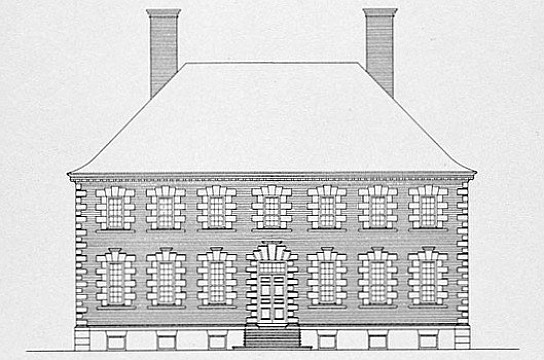Cleve
near Fredericksburg, King George County, Virginia
Completed in 1747, for Charles Carter (1707-1764) and his second wife, Anne Byrd (1725-1757), of Westover. Having been resident at nearby "Stanstead," Carter was remarried in 1742 and used Anne's £1,500 dowry to construct their new home which he duly left, not to his eldest son, but to their eldest son, John Carter. Cleve was a seven-bay, hipped-roof house with a frontage of 67-feet, built under the supervision of master mason William Walker and it was noted for its detailed, ornamental stonework. Although the house is no longer, the wine-growing tradition first established here by Charles Carter from 1759 continues to this day as the Philip Carter Winery....

This house is best associated with...
By 1762, Charles Carter had planted 1,800-vines at Cleve from two grape varieties and he sent a case of his samples to the Royal Society of Arts in London. Both were approved as "good wines” and Carter was awarded a gold medal as the first person to make a, “spirited attempt towards the accomplishment of their views, respecting wine in America.”
The house itself was gutted by a fire in 1800 while it was home to Carter's younger son, Landon Thornton Carter. In 1852, after the death of his son, St. Leger, the estate was sold to Henry Byrd Lewis, a nephew of St. Leger's brother-in-law, John Lewis (nephew of George Washington). As a testament to its original construction, Henry Lewis was able to retain the existing walls and brickwork and he rebuilt the house with a new, albeit less conspicuous roof. His grandson, John Armistead Lewis, was living here in 1915 when a second fire put the house to ruins again and it was demolished two years later in 1917. However, as a reminder of what was lost, the east elevation of Fairfield bares a very close resemblance to how the front of Cleve might've looked if still standing today.
The house itself was gutted by a fire in 1800 while it was home to Carter's younger son, Landon Thornton Carter. In 1852, after the death of his son, St. Leger, the estate was sold to Henry Byrd Lewis, a nephew of St. Leger's brother-in-law, John Lewis (nephew of George Washington). As a testament to its original construction, Henry Lewis was able to retain the existing walls and brickwork and he rebuilt the house with a new, albeit less conspicuous roof. His grandson, John Armistead Lewis, was living here in 1915 when a second fire put the house to ruins again and it was demolished two years later in 1917. However, as a reminder of what was lost, the east elevation of Fairfield bares a very close resemblance to how the front of Cleve might've looked if still standing today.
You May Also Like...
Categories
Styles
Share
Connections
Be the first to connect to this house. Connect to record your link to this house. or just to show you love it! Connect to Cleve →










